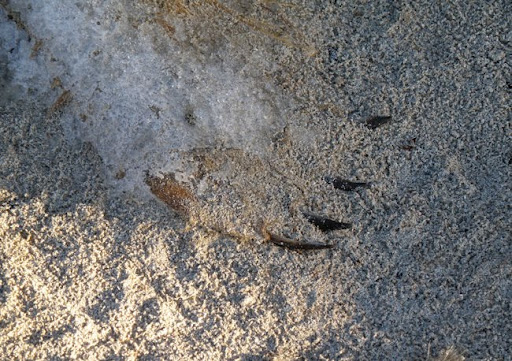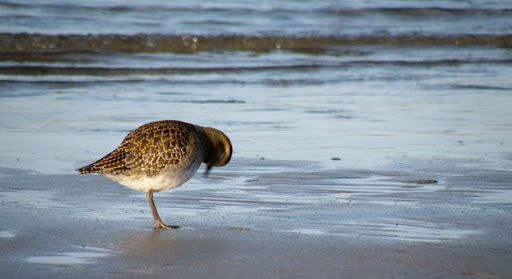
Image above: The mark left by a hawk's beak in a seagull’s feather
The Web
Thursday 14th January
A sparrowhawk rises from the jumble of rocks that make up the shoreline. Its wings are stiffened, thumb feathers drawn in like the hand of swimmer pushing water. It tilts its body as if a sudden gust has caught it off guard and in doing so flashes the white of its chest against the darkness of a rain shadow. Its a female and she puffs away over heather hugging the contours until she is out of sight. I amble over wondering if I had disturbed her while she was with a kill, although her talons had been empty. I find only sea tossed debris, polystyrene and plastic bottles.
Forgetting the hawk I move on enjoying the unfamiliar softness of boggy ground after a month of hard labour on frozen earth. The Sound of Iona is all chop, waves beating relentlessly again the rocks with all the ineffectualness of child’s tantrum. A hundred yards on and lost in thought the first feathers of a kill go unnoticed until I stumble into the midst of what looks like a pillow fight gone wrong. I look for a carcass or a trace of bloodied flesh but it has gone, only the feathers remain. I collect some primaries for identification and guess the victim was a seagull. Today is not the day for unpicking a crime scene, the hawk may only have been responsible for the idea of a kill rather than the culprit.
Back at home, I retrieve the feathers from my pocket and place them in order of size. Five are from the right wing with one stray from the left; its camber arcing in opposite direction. Superficially they appear to be in good condition, their quills still intact despite having been grasped and ripped from the wing. The soft parts are pock marked and I remember the shape of a hawk’s bill from other encounters. This is frenzy, each tiny mark is the jabbing of a beak as it searches for a lever to grasp. There a hundreds of these punctures in my small collection of feathers to have plucked the whole bird with one beak seems almost a labour of love.
I fish out my microscope from the bottom of the bookcase and set it up on the windowsill table. Outside dusk has begun to gather about the mountains. Ben More the highest of the range has spent the day shrouded in mist and there are no fireworks this evening as the sun leaves the bay to climb the heights. Even on a low magnification the feather gives up its intricacy. Each tiny filament that branches away from the central quill is fringed with rows of fine barbs that mesh with those of the neighbouring filaments; creating a web both strong and yet flexible. I move the feather and find a puncture and imagine the shape of the bill its hollow triangular section indelibly marked into the web. Part of me understands the hawks frustration, grasping at something so apparently solid that it can cradle the wind and yet still be so insubstantial. Despite the hole the web stands, but other feathers have almost lost their rigidity under the assault.
I look for the marks left by the beak’s final grip on the shaft as it pulled the feather from the flesh and find a delicate pinhole. On others the force exerted by the tip of the bill has shattered the translucent quills like a biro crushed underfoot. I pack away the microscope non the wiser as to the culprit, higher magnifications always expose the gaps both physical and in my understanding of the world. Tonight the wind is already erasing the drama from the landscape and feathers will reclaim their anonymity freed from the burden of being evidence.




